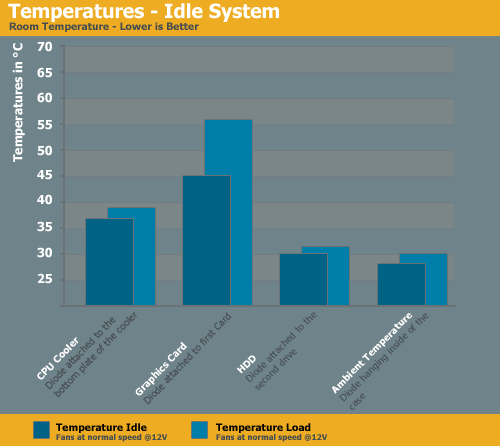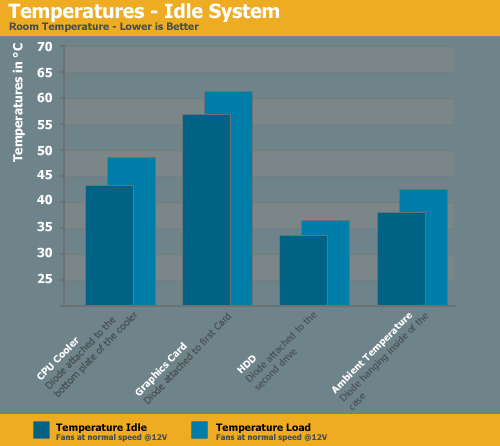Silverstone Fortress FT01
by Christoph Katzer on November 10, 2008 5:00 AM EST- Posted in
- Cases/Cooling/PSUs
Temperatures and Acoustics
We measure the temperatures and acoustics at two different settings: idle and load. For the idle test, we leave the PC sitting at the Windows desktop without any additional running programs. We let the system idle until temperatures stabilize (around 30 minutes) and then take our temperature readings. For load testing, we run the Fur Benchmark for the graphics cards and BOINC for the CPU. In general, the temperature stabilizes after around 20 to 30 minutes, but we run the load tests for 60 minutes and take the highest temperature during this time.

The CPU cooler has an easy job this time with premium airflow directly from above. However, the graphics cards have a more difficult job keeping cool, since there is no fan on the side panel and there are obstructions between the graphics cards and the intake fans. We see the results of this particularly at higher loads; the graphics cards do okay but definitely don't stay cool. Then again, high-end graphics hardware like this tends to run hot at full load.

So what about reversing than directions -- does the Silverstone marketing touting the benefits of positive pressure cooling show up? Compare the two temperature graphs, and the answer is a resounding yes! Besides the fact that reversing the top fan direction required a fair amount of effort, there's absolutely no good reason to change the orientation. Couple in the added benefits of reduced dust accumulation because of the filters, and we have to agree with Silverstone. You may not see such dramatic differences on other cases, but the Fortress FT01 definitely works well in the stock configuration, and modifying the fan arrangement appears to cause more harm than good.

As mentioned already, the current test system definitely is not designed to eliminate noise. As such, most of the noise output comes from the fans on the graphics cards. The fans on the Silverstone Fortress FT01 are not connected to a fan control, so they always use 12V. However, in subjective testing we felt that the case fans were very quiet and should not present a problem for users looking to build a low noise system. Again, we will investigate this further in the future with a different test configuration.










22 Comments
View All Comments
billt - Monday, November 10, 2008 - link
Good looking case. But then I am partial to Silverstones; have a TJ09 and a SG03 (neither overheat). Wish they had made this case 1-2" deeper.MrX8503 - Monday, November 10, 2008 - link
I think antec might of been the first ones to have the psu at the bottom, but what silverstone did to their psu is ingenious!I like how the psu fan is flushed to the bottom hole of the case with a filter on it. This lets the PSU suck air from the outside of the case and is separate from the entire case air flow.
SilthDraeth - Monday, November 10, 2008 - link
What amazes me, is you can get a bling bling case for $50. But if you want a simple case like this it will cost you around $200.I know quality of craftsmanship is one thing, but there is no reason you shouldn't be able to get aesthetics like this in a $50 case. It could look similarly, but maybe have a few sharp edges that need to be filed by the purchaser.
Vidmar - Wednesday, November 12, 2008 - link
That hard drive cage is a real problem with airflow. For what this thing costs I would expect a high end power supply as well.For my $$$ this Rosewill R6AR6-BK case has almost all of the features of that case, cooler performance and at 1/4 of the cost!
http://www.newegg.com/Product/Product.aspx?Item=N8...">http://www.newegg.com/Product/Product.aspx?Item=N8...
Sunrise089 - Monday, November 10, 2008 - link
The TJ-07 model from Silverstone is a popular case for watercoolers. Does this case replace the TJ-07, or is there an even larger 180mm equipped case in the pipeline?Cardio - Monday, November 10, 2008 - link
I have had 3 of their cases and while well made, they all had extremely poor thermal performance. Could only run one of their expensive HTPC cases with the top removed! Very poor engineering as far as I am concerned. Never again they must not even test these things!HOOfan 1 - Monday, November 10, 2008 - link
Looks a little like the Coolermaster RC-690HOOfan 1 - Monday, November 10, 2008 - link
also it is nice for a change to see a black case with a black back panel....strikeback03 - Monday, November 10, 2008 - link
For reversed fan flow measurements, did you reverse all the fans? So that the rear 120 would be the only intake, and most airflow from it would be sucked right back out by the 180 on top? How would a more Antec-like configuration, with front intake and both rear and top exhaust, work? Also, would the stock fan configuration have any negative impact on air flow around a larger tower style cooler?Also, you mentioned that you wouldn't recommend using a PSU with an 80mm fan, why is that?
Christoph Katzer - Monday, November 10, 2008 - link
No, just the large one on top (then according to ATX spec) to see the difference. No 80mm-fan-PSU because one with 120mm fan can get fresh air through the bottom.